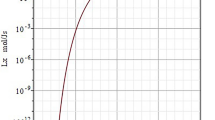Abstract
In this chapter we study chemical equilibrium reactions. In thermal equilibrium of forward and backward reactions, the overall reaction rate vanishes and the ratio of the rate constants gives the equilibrium constant which usually shows an exponential dependence on the inverse temperature. We derive the van’t Hoff relation for the equilibrium constant and discuss its statistical interpretation.
Access provided by CONRICYT-eBooks. Download chapter PDF
Similar content being viewed by others
In this chapter we study chemical equilibrium reactions. In thermal equilibrium of forward and backward reactions, the overall reaction rate vanishes and the ratio of the rate constants gives the equilibrium constant which usually shows an exponential dependence on the inverse temperature.Footnote 1 We derive the van’t Hoff relation for the equilibrium constant and discuss its statistical interpretation.
1 Arrhenius Law
Reaction rate theory goes back to Arrhenius who in 1889 investigated the temperature-dependent rates of inversion of sugar in the presence of acids. Empirically, a temperature dependence is often observed of the form
with the activation energy \(E_{a}\). Considering a chemical equilibrium (Fig. 14.1)
This gives for the equilibrium constant
and
In equilibrium the thermodynamic forces vanish
For dilute solutions with
we have
which gives the van’t Hoff relation for the equilibrium constant
The standard reaction free energy can be divided into an entropic and an energetic part
Since volume changes are not important at atmospheric pressure, the free reaction enthalpy gives the activation energy difference
A catalyst can only change the activation energies but never the difference \(\varDelta H^{0}\).
2 Statistical Interpretation of the Equilibrium Constant
The chemical potential can be obtained as
Using the approximation of the ideal gas we have
and
which gives the chemical potential
Let us consider a simple isomerization reaction
The partition functions for the two species are (Fig. 14.2)
In equilibrium
This is the thermal distribution over all energy states of the system.
Notes
- 1.
An overview over the development of rate theory during the past century is given by [49].
Author information
Authors and Affiliations
Corresponding author
Rights and permissions
Copyright information
© 2017 Springer-Verlag GmbH Germany
About this chapter
Cite this chapter
Scherer, P.O.J., Fischer, S.F. (2017). Equilibrium Reactions. In: Theoretical Molecular Biophysics. Biological and Medical Physics, Biomedical Engineering. Springer, Berlin, Heidelberg. https://doi.org/10.1007/978-3-662-55671-9_14
Download citation
DOI: https://doi.org/10.1007/978-3-662-55671-9_14
Published:
Publisher Name: Springer, Berlin, Heidelberg
Print ISBN: 978-3-662-55670-2
Online ISBN: 978-3-662-55671-9
eBook Packages: Physics and AstronomyPhysics and Astronomy (R0)






